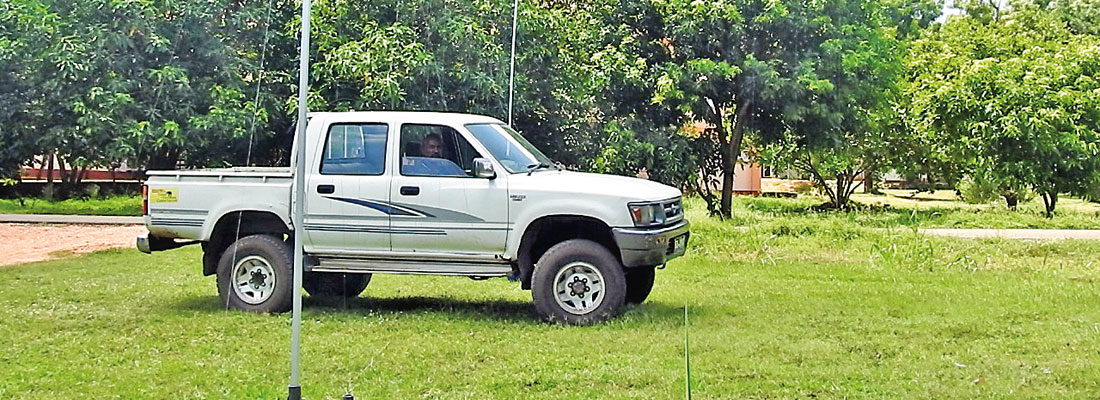News
Hanging electric fence delivers a brief jolt to deter jumbos
View(s):By D.Thiviyatharshini
A hanging electric fence which deters elephants but allows people and smaller animals, and covered vehicles to move beneath it, has been found to be more effective and less costlier, a researcher believes.

Dr. S. Wijeyamohan
A conventional electric fence is not effective against elephants who find ways to dismantle the barrier.
A simple double-sided hanging electric fence was invented by Dr. S. Wijeyamohan, head, department of bio-science, University of Vavuniya, and patented by the university.
Dr Wijeyamohan, said the new vertical electric fence has been developed with ecological considerations. The conventional horizontal design restricts the movement of various animals, particularly larger mammals. The conventional fence consists of three wires; the top and bottom wires are live wires, and an earthing wire in the middle. This configuration ensures that animals taller than one foot, including humans, are unable to cross the barrier.
And also, the elephants know how to break this, because the posts in the horizontal fence are the weakest point. They put heavy objects on top of them to break the fence.
“When you have the horizontal wire running across the border between the elephants and the humans for several kilometres, there are fences sometimes up to 40 km, and people need to use elephant crossing areas for various other purposes. The traditional fence became a barrier to humans as well. So they also cut and opened the horizontal fence, or broke the fence and blamed the elephants, ” said Dr Wijeyamohan.
Even vehicles can go through the double-sided vertically hanging electric fence without passengers being stunned by an electric jolt.
A horizontal wire is positioned at a height of 14 feet to ensure that even the tallest elephant in the country, which won’t be above 12 feet, is unaware of its presence. While the elephants can see the wire, they cannot perceive it unless they raise their trunks to touch it.
The wires are hung vertically at half-metre intervals, stopping four feet above the ground, allowing space for other animals and humans to pass through.
At the same time, the vertical wires have a free end at the bottom. They dangle so that the elephant cannot throw any objects to break them.
Before this model was tried, there was an L-shaped model with the post established in Hambantota in 2016, where the extending L portion faces towards the elephants’ side. But the new model is a double-sided one. That means there is no L-shape, it is a straight one. So it is effective from both sides.
An elephant could push the entire structure of the previous model from behind, but not this one.
The post is also electrified on an insulator. The elephants cannot strike the insulator with their feet or trunks. These characteristics demonstrate the efficiency of the model.

A vehicle can go under the fence without a hindrance
Compared with the conventional and previous models, it is cost-effective.
The electricity supply is the same as the supply given to the horizontal wires.
The conventional energiser is not fatal to any living creature.
The energiser supplies electricity up to 10,000 volts in brief pulses lasting 0.3 to 3 milliseconds, with intervals of about 1.8 seconds in between. Despite the high voltage, the short duration and low current make it not fatal, allowing time to withdraw between pulses.
Originally invented in New Zealand for cattle farms, this technology is now also used to keep off elephants, provided that fencing is well-maintained.
Key materials include stainless steel wire, aluminium bar, and PVC pipes. The stainless steel wire is 0.1 millimetre thick and it does not corrode. It is much lighter than galvanised wire, with two kilometres of it weighing only about 12 kilograms.
Compared to galvanised wire, it can deliver a significant shock to the elephant.
“The post is made with an aluminium square bar, which is light and strong. But, the strength of a post is irrelevant as long as there is electricity. This is why we used an aluminium box bar on the PVC pipe.’’
Concrete is poured into the PVC to strengthen it. How long it can last is not known, but expected to last at least five years. The aluminum bar and the stainless steel will not corrode or oxidise because they are coated.
Still, the PVC, which can deteriorate with temperature change and poses a fire risk. If there’s a fire, the PVC will melt and weaken the fence.
While stronger options like fibreglass or ceramic exist, they are costlier. PVC is also practical when replacement is needed.
The first model of this fence was installed at Mannakandal in the Puthukudiyiruppu Divisional Secretary area, Mullaitivu district. It was erected around the M/Mannakandal Tamil Mahavidiyalayam.
The best way to say that you found the home of your dreams is by finding it on Hitad.lk. We have listings for apartments for sale or rent in Sri Lanka, no matter what locale you're looking for! Whether you live in Colombo, Galle, Kandy, Matara, Jaffna and more - we've got them all!

